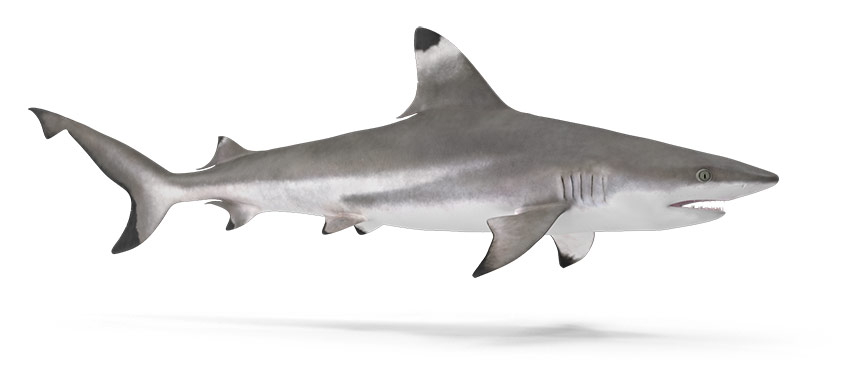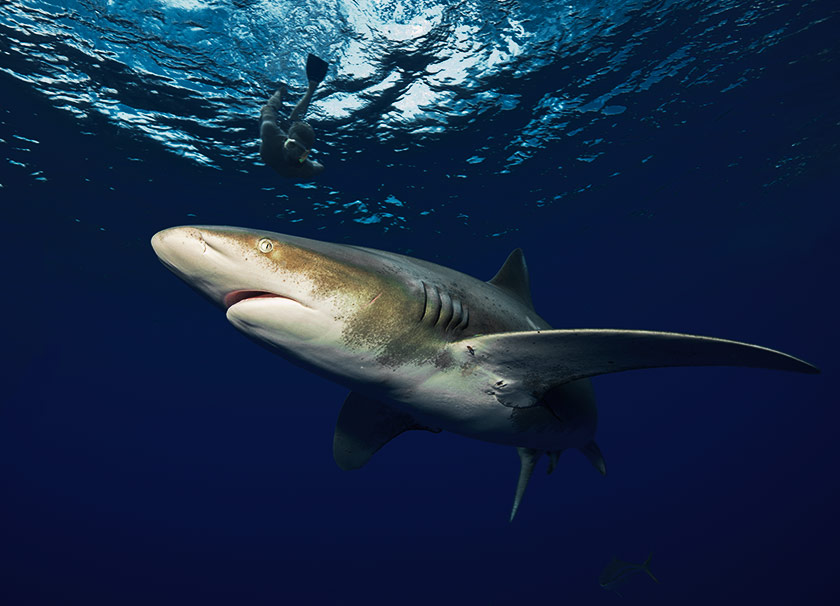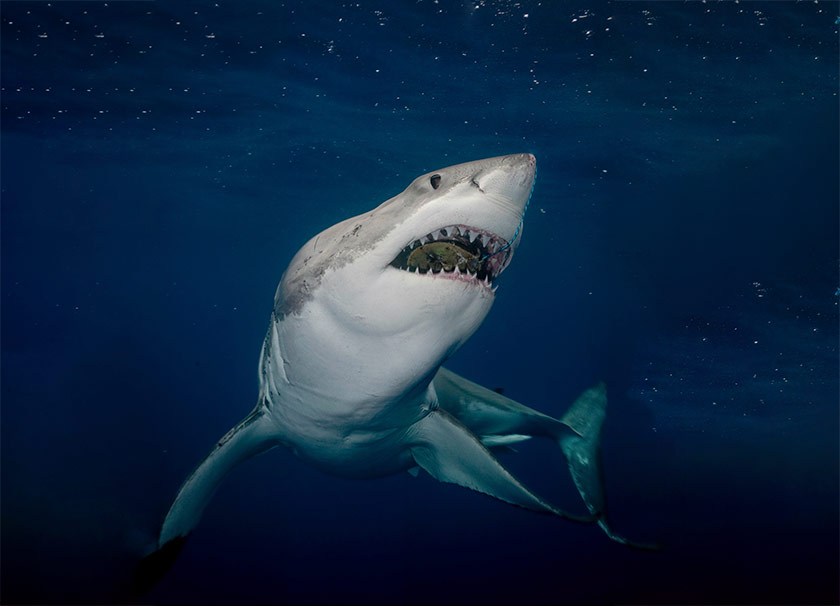How to Survive a Shark Attack

Scenario: You’re stranded in the ocean and a shark is circling you. What do you do?
I’ll outline here how to survive a shark encounter and give you the best advice (according to science), to stay safe in the big blue.

Shark Basics
We should probably stop for a second and remember that sharks are a name describing over 500 species. All of them have teeth, but only a few are known to bite, let alone be any danger to humans. I say this so you don’t fall into the trap of making generalizations about this broad category of cartilaginous fishes.

But the fact still remains: they have a lot of teeth and sometimes they bite people. So, what do we need to know to keep these random acts from happening to us?
Why do sharks bite humans?
Have you ever heard people say, “we’re not on the menu for sharks!” I have. As a marine biologist I tell myself that every time I get in the water. Sometimes I repeat it over and over again as I swim in murky water. I think it helps. I also told that to the open ocean swim team I coached for two years. Unfortunately, after I left that club, a shark attack happened on a nearby beach. I wonder what the coach told them after that incident?

The point is, while it’s generally true that sharks don’t have us on the menu, they could. Just like we don’t normally eat cockroaches, we could. Probably not a perfect analogy, but you get the point. We’re looking at exceptions.
Put yourself into the brain of a shark quickly for our hypothetical thought experiment here. You have a shark brain – which is very different from humans, so you’re roaming the ocean with a skill set that’s highly tuned to keep you alive in the world you evolved in (a world many millions of years before us). Your very species’ survival depends on getting enough food to get big enough that you can produce little baby sharks.
Each shark species has become really good at eating a particular set of prey, and their behavior is matched to finding and eating it. If we study their feeding and hunting behavior, we can reverse engineer our survival scenarios for each type of shark. Let’s get to it with some general advice.
Scenarios to avoid
This might seem obvious, but you’re going to want to avoid any situation that makes you either look like shark-food, smell like shark-food, sound like shark food, or are in the water during dinner time. Let’s break it down.
Avoid Dusk and Dawn
Many of the sharks that bite humans are feeding at dusk or dawn, a time scientists call crepuscular. It’s this tricky time when shark-food has a harder time seeing the sharks coming. It’s also a great time to catch that last wave of the day, so surfers beware!
Avoid Murky Waters
Many sharks prey on schools of fish or invertebrates that swim in murky waters near shore. It’s easy to mistake a splashing appendage for a school of fish if they can’t even see you well.
Avoid swimming near their prey
This goes for swimming around boats that are cleaning fish, off fishing piers, and docks used for fishing. Also – islands full of seals, but that seems more obvious. You basically want to avoid swimming in areas that the sharks have learned to associate with food.
—
Before I get to the sharks that are considered the most dangerous, let me quickly point out a shark that is just so unusual and fascinating that I have tell you about it. My hope is that this helps you see the importance of habitat and the probability of encountering a shark when discussions of “danger” are brought up.
The Cookiecutter Shark
I think the cookie cutter shark would be the most feared shark in the sea if only humans bumped into them more often. It lives in the open ocean and feeds at night. That means almost no one runs into one. But if you are in the habit of swimming across the open ocean at night, make sure you pay very close attention here.
Let me describe this tiny, yet ferocious shark for those that have never seen it. They look like big cigars with overly large eyes and a funny looking cartoon mouth – think of an eel with shark teeth.
What makes these sharks really stand out is their unusual bite. It’s a perfect circle! They’ve found these circular bites taken out of whales, large fish, and even nuclear submarines. Again, for humans, you don’t need to worry much unless you’re in the open ocean at night and look somewhat like a big fish.
So far, we only have one well documented bite incident. A swimmer was making an open ocean swim between islands in Hawaii as the sun set. He swam into a group of bioluminescent squid and felt something bite his chest! Then he felt another bite. He quickly jumped onto the support kayak to see that the holes in his chest were perfect circles – 4 inches across and almost an inch deep. Classic marks from the cookiecutter shark.
The Most Dangerous Sharks
Out of the more than 500 shark species on planet Earth, only the following four have more than 10 unprovoked, fatal attacks on humans.
1. White Sharks

After Jaws was released in 1979, white sharks (what people in the film referred to as great whites) took the stage as the most feared sharks, and for good reason. They mainly hunt seals and other large mammals, so humans floating on the surface of the ocean can easily be mistaken for food. Even just a single bite by a large white shark like this can cause death by blood loss. There’s no sugar-coating this one. Much like Russian roulette (although with better odds), your best chance of survival is avoidance or luck.
How not to be white shark food
Don’t swim near seals, and pay attention to when white sharks might be in the area. Old studies indicate that these sharks are attracted to bright colors. There is also plenty of anecdotal evidence that white sharks attack seals from below and, given that surfers kinda look like seals, that could put them at greater risk. Unfortunately it’s really hard to do rigorous scientific research on these topics. It’s best just to avoid swimming in areas and at times where white sharks appear more frequently. In Cape Cod for instance, you might not want to swim in the ocean from June to August. In Monterey Bay, they are most abundant in late summer and early fall.
2. Tiger sharks
Tiger sharks are big and curious. Sometimes they’re referred to as living trash cans with mouths. People have found everything from license plates to parts of tires in their stomachs. This is because they’ll bite just about anything to see what it is. It’s how they test the edibility of objects in the water.
This means they have been known to approach a swimmer to take a test bite to see what it is. The attack might not be fast, but if you didn’t see it coming, you’re in trouble.
How not to be tiger shark food?
Keep alert. Always look around for the “lazy trash can with teeth.” It sounds simple, but you can likely avoid these relatively slow-moving sharks if you remain vigilant during your swim. Then again, they’re also routinely seen chasing down and killing dolphins off the west side of Oahu.
Should a tiger shark approach you however, there are a few techniques that seem to work. If you have an object, like a camera or stick with you, you can put that between you and the shark. If it approaches more, a nice punch in the nose often deters them. Or during approach you can try the more advanced move of pushing yourself over the shark. Place a hand on its nose, lock your arm and push your way up and over the shark to keep your body away from its shark teeth. These were some of the techniques I was going over in my head as the kids were waving at us from the shore warning us of that approaching tiger shark.
3. Bull sharks
The movie Jaws was actually inspired by a series of real life, fatal attacks in New England in the early nineteenth century. However, it’s thought that because of the location of some of the attacks along estuarine rivers, that they may actually have been a few bull shark attacks – not just a rogue white shark.
Bull sharks can be very curious and occasionally aggressive. Add to that the fact that they can swim up rivers hundreds of miles into freshwater, and you have one of the most dangerous sharks.
In fact, bull sharks can actually survive entirely in freshwater. They’ve been found 2,500 miles up the Amazon. They’ve also been found up the Mississippi as far north as Illinois and Minnesota. And in Central America’s largest lake, Lake Nicaragua, there are resident bull sharks.
How to not be bull shark food
If you’re in warm, murky riverine waters, you’re in an area that could have a bull shark. The chances are low of being bitten, but it’s still advisable to avoid murky waters and don’t splash around like a wounded fish. You may just attract a bull shark that comes in to take a test bite.
4. Oceanic Whitetips
The oceanic white tip shark lives in the open ocean. They rarely go anywhere near the shore, and thus are unlikely to encounter most humans. However, it’s believed that castaways and victims of shipwrecks may fall victim to these sharks more than any other.
The dangerous thing with oceanic white-tips is that they’re very aggressive and curious. They don’t have the same fear of approaching a human that other sharks have. So, if you happen to be in the water and see an oceanic white-tip, you should probably get out of the water as quickly as you can.
How to not be oceanic white-tip shark food
Most oceanic white-tips are in the open ocean where the water is clear. It should be fairly easy to see an oceanic white-tip coming, so stay alert if you’re swimming in the deep blue. When you see one, unless you’re with trained professionals, the sighting would be your que to get out of the water.
Why I wrote this: a personal account
On our honeymoon in Kona, Hawaii, Haley decided to take me on a fun snorkel in the ocean. The waters were clear and it was amazing fun to see the other fish swimming around. At some point, we looked up to see three kids scrambling out of the water onto the reef with the fear of God in their eyes. They started yelling at us. Two were waving their arms and one was putting his hand on his head signaling a shark fin.
I knew that sign. I thought to myself, “if this is how I go, I’m going to go fighting.” We locked arms back to back so that we could keep an eye in all directions and headed for shore. I’m sure it looked humorous – or scary. I don’t know. We were scared.
We didn’t see it at the time, but apparently there was a massive tiger shark circling us in the bay staying just out of our vision. I definitely paid more attention while snorkeling after that.
If we start looking like the prey of a shark, it’s possible they’ll attempt to bite. It’s not even that they’re confused. They have certain behavioral cues that trigger feeding responses (that’s how we talk in behavioral ecology circles). Basically, you look like a shark-food, you might become shark-food.
Just remember, no shark has ever evolved a taste for humans – we just don’t go into the ocean enough.
A list of sharks that have bitten people
- White
- Requiem
- Wobbegong
- Blue
- Sand tiger
- Hammerhead
- Tiger
- Bull
- Blacktip
- Shortfin Mako
- Blacktip reef
- Grey reef
- Oceanic whitetip
- Lemon
- Bronze whaler
- Spinner
- Galapagos
- Cookiecutter
- Blacktip
- Nurse
- Seven gill
- Carribean reef
- Porbeagle
- Galapagos
- Dusky
- Tope
- Port Jackson
- Guitarfish
- Leopard
- Mako
Why I wrote this article about sharks
Sometimes I wish my initial view of sharks hadn’t been shaped entirely from movies and TV. Mainstream media has been fixated on portraying the dangerous side of sharks even before the movie JAWS came out in the 1970’s. But that’s not the whole story. Not all sharks are dangerous either. It is, however, important to note the evolution of shark behavior and see how it relates to why people may be attacked. For me this makes them a bit less scary and it gives you tools to take with you when you set foot in the ocean.

Prefer Listening?
To make this article about surviving a shark attack more accessible I recorded this narrated version. Enjoy.
More Video on Shark Attack Avoidance
This article was kindly reviewed by Shark Expert: Dr. Nick Whitney from the Anderson Cabot Center for Ocean Life.

